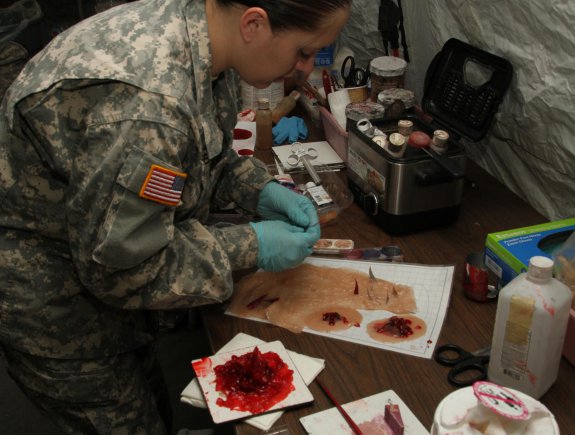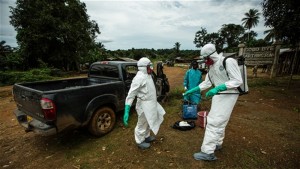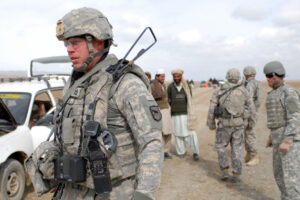
An Army reservist conducts medical training.
AUSA: Even as the first wave of 4,000 Army regulars deploys to West Africa, the service’s mobilization command is preparing for a possible call-up of Reserve and National Guard troops to replace them in six months, Lt. Gen. Michael Tucker told me today. “There are no orders yet,” the First Army commander cautioned, just precautionary planning. But with Ebola on the rise and most of the Army’s medical personnel resident in the so-called Reserve Component, a spring 2015 deployment looks likely.
Fighting a virus instead of terrorists, wielding syringes instead of rifles, wearing plastic hoods instead of helmets: It would be a different kind of mission for the Reserve and Guard from the 13 years of land war that have consumed them since 9/11. It’s also an exemplar of the wider variety of non-combat missions the Army expects be doing in the future. And it’s a new kind of challenge for which First Army is reorganizing even as it shrinks. Tucker’s task is to maintain close ties between full-time and part-time soldiers, despite smaller budgets and growing tensions between the active and reserve components.

A USAID burial team works with Ebola victims in Monrovia, Liberia.
“Their success is our success; if they fail, we fail,” said Tucker, an active-duty officer whose whole job is supporting reserve readiness. “I can’t underscore that enough.”
“There’s some turmoil spinning, OK, no question,” Tucker said understatedly. “When you talk about pulling units out of states, that gets personal down in hometown USA. I understand that. But my ability to do my job, to partner with all these reserve component leaders and all these TAGs [the adjutants-general who command the Guard in each state] is based on me establishing absolute-without-question trust with them, and I have worked very hard at building this trust.”
Just last week, Tucker said he convened his brigade commanders and command sergeant majors at First Army headquarters to tell them, “if you can’t establish a relationship of trust with your counterpart, you’re ineffective to me, you cannot do your job,” he recounted. “So if you’ve got sharp elbows, file ’em off.”
No group has been more vocal in criticizing active Army leadership than the National Guard Association of the United States. But NGAUS invited Tucker to brief them on First Army’s changing role, he said, and at the end, “I got a standing ovation.”

Lt. Gen. Michael Tucker
Tucker gets to be the active Army’s good cop in the AC/RC relationship, the guy who goes to the Guard with resources to help them train. He doesn’t have to be the guy who tells them to give up their Apache helicopters to active squadrons or to downsize units. “I’m not part of that decision-making,” he told me.
“I’m bridging across all these components,” he said. “They intuitively are not going to draw to each other, they need to have an agent that brings them together.”
That’s part of the Army’s 2012 Total Force Policy to continue a close working relationship between active and reserve component soldiers even after the have stopped routinely deploying into battle side-by-side. It requires shifting First Army’s focus from preparing mobilized RC soldiers to go to Iraq or Afghanistan — 90,000 of them in one year at the height of the surge — to supporting non-mobilized units’ regular weekend drills and annual exercises.

Gen. Mark Milley
Conversely, more Reserve and Guard troops will participate in active units’ rotations at the Army’s famous Combat Training Centers, said Tucker’s boss, Forces Command chief Gen. Mark Milley, in a press briefing at the Association of the US Army conference here. “At those training centers in years gone by, we’ve had 18 to 20 percent reserve component [personnel] participation in an active component rotation,” i.e. when an active-duty brigade went through wargames, Milley told reporters yesterday.”[We’ll] try to amp up the percentage [until] about 50% of a given rotation at the CTCs are reserve component.”
At First Army, Tucker doesn’t control vast training areas like the CTCs. But he can help RC units organize much more elaborate exercises than they could do on their own, bringing together units from multiple states and even from the active-duty force. “You can’t expect them to have that kind of rolodex,” he said. “[But] if you just had the Guard training the Guard, [say] a transportation company out there by themselves, who are they out there hauling equipment or ammo for or food or water? So give them a unit to support” — or to fight: Tucker got full battalions from the famed 82nd Airborne Division and other active-duty units to play the part of the bad guys (formally, the “opposing force” or OPFOR) in seven Guard exercises.
First Army has do all this as it downsizes. By consolidating units, shrinking the headquarters that remain, and centralizing functions at First Army HQ in Rock Island, Illinois, “we’re going to save about $13 million the first year, and we’ll save another $6 million every year after that,” he said. Currently, 60 percent of First Army personnel are hands-on trainers: By the end of 2015, as overhead is stripped away, that will be up to 87 percent. It all boils down, Tucker said, to “can I train more soldiers better with less money.”

First Army is shifting from primarily supporting post-mobilization, pre-deployment training for Iraq and Afghanistan to supporting more weekend drills and summer exercises.
True, the demand for post-mobilization, pre-deployment training is way down, from a peak of 90,000 RC soldiers during the surge to 30,000 in fiscal 2014 and 15,000 by 2016. But First Army support for pre-mobilization training, training not associated with a specific deployment, is supposed to go up steeply. That should make it easier for RC units to respond to short-notice contingencies like Liberia, Tucker said.
In the Reserve Component, Tucker said, “they don’t want to ever go back to being a strategic reserve” — as in the Cold War, when the reserves were never mobilized for Vietnam — “they want to remain an operational reserve”– deploying regularly to real-world operations, as they have since 1991 and especially since 9/11.” With First Army providing more support to RC weekend drills and annual exercises, he said, “we will actually reduce the period of post-mobilization [training], making them more operational [and] more ready.”
But how ready, how fast, for what? “There’s a lot of talk about how long does it take to a get brigade combat team ready for deployment in the National Guard. [Well,] what you want them to do?” Tucker said. “If we want them to do full combat operations, we don’t have any data.”

South Dakota National Guard soldiers on duty in Afghanistan.
“No Guard or Reserve unit has deployed since 9/11 that was deployed in order to conduct its core combat mission,” Tucker said. “They were there for security force assistance, advice and assist — and, y’know, the majority of our force were doing those anyway.”
Those words won’t be welcome in the Guard, which prides itself on its combat brigades. Whether Guard infantry, armor, and attack helicopter units in Afghanistan and Iraq did missions as demanding as their active duty counterparts is a charged issue. But with the active Army leadership increasingly emphasizing non-combat missions like Liberia, support troops may get a lot more prominence — and the Reserve Component has most of the support troops.
France, Germany ink deal on way ahead for ‘completely new’ future European tank
Defense ministers from both countries hailed progress on industrial workshare for a project that they say “will be a real technological breakthrough in ground combat systems.”


























